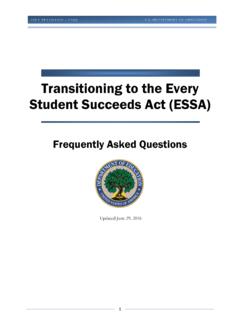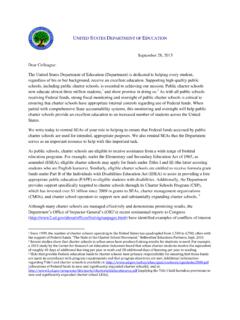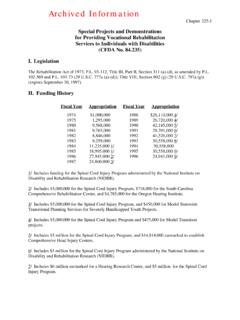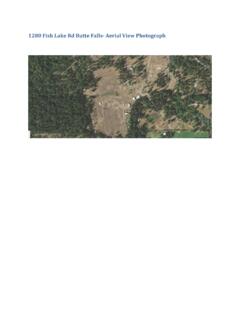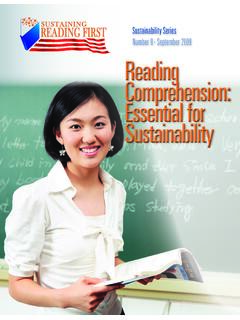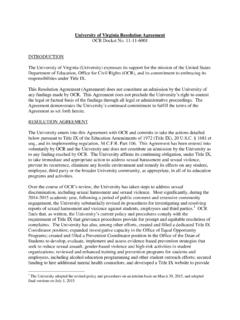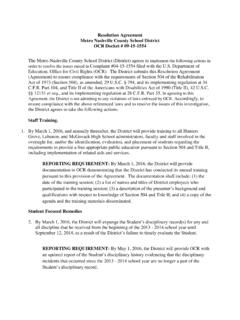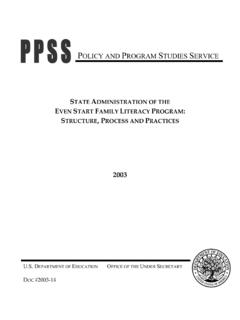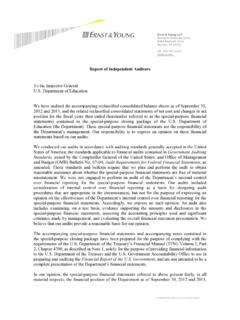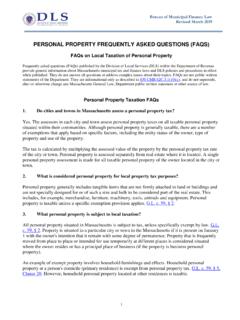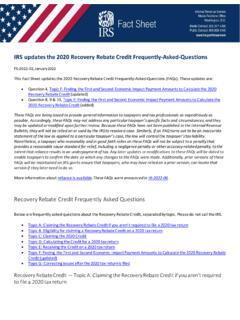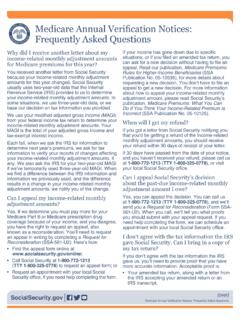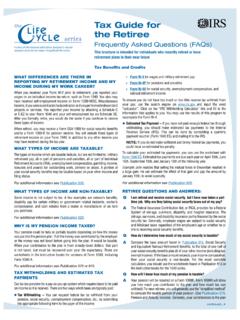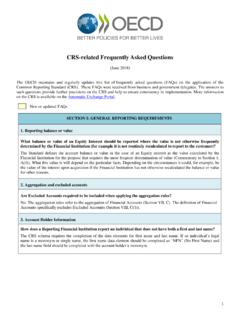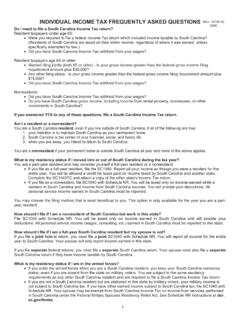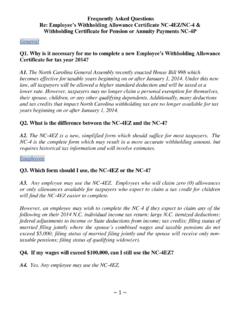Transcription of Higher Education Emergency Relief Fund III Frequently ...
1 Higher Education Emergency Relief Fund III Frequently asked Questions American Rescue Plan Act of 2021 Published May 11, 2021 Questions 7 and 11 updated May 24, 2021 question 36 updated September 30, 2021 Other than statutory and regulatory requirements included in the document, the contents of this guidance do not have the force and effect of law and are not meant to bind the public. This document is intended only to provide clarity to the public regarding existing requirements under the law or agency policies. 2 Table of Contents A. Overview Questions .. 3 B. Emergency Financial Aid Grant to Students Questions .. 7 C. Institutional Uses of Funds Questions .. 11 D. New Required Uses of Funds Questions .. 16 E. Grant Administration Questions .. 20 3 Higher Education Emergency Relief Fund III Frequently asked Questions (FAQs) On March 11, 2021, President Biden signed the American Rescue Plan Act of 2021 (ARP) (Pub.)
2 L. 117-2). The ARP appropriated approximately $ billion for the Higher Education Emergency Relief Fund (HEERF) and represents the third stream of funding appropriated for HEERF to prevent, prepare for, and respond to coronavirus. Taken together, the Coronavirus Aid, Relief , and Economic Security Act (CARES Act) (Pub. L. 116 136), the Coronavirus Response and Relief Supplemental Appropriations Act, 2021 (CRRSAA) (Pub. L. 116-260), and the ARP represent HEERF I, HEERF II, and HEERF III, respectively. HEERF III is structured like the HEERF II programs under the CRRSAA, with certain important differences that will be discussed within these FAQs. These FAQs are intended to describe the features and allowable uses of grants received under the HEERF III programs and may be updated with additional information in the future. A. Overview Questions 1. question : What changes did Congress make to the HEERF programs in ARP (HEERF III) that are different from the HEERF programs in CRRSAA (HEERF II)?
3 Answer: Congress made the following major changes in creating the HEERF III programs: Provided supplemental funding under the CRRSAA framework: As noted above, Congress appropriated approximately $ billion to be distributed under the following funding streams originally established within the CRRSAA: Approximately $36 billion under ARP (a)(1) for public and private nonprofit institutions as defined in section 101 or section 102(c) of the Higher Education Act of 1965, as amended (HEA). At least half of an institution s allocation under ARP (a)(1) must be used to make Emergency financial aid grants to students (the Student Aid Portion); the remainder may be used for institutional purposes (Institutional Portion). For more information on how the minimum amount that must be used for grants to students is determined under ARP, see question 20 or the ARP (a)(1) methodology document.
4 Approximately $3 billion under ARP (a)(2) for Historically Black Colleges and Universities (HBCUs), Tribally Controlled Colleges and Universities (TCCUs), Minority Serving Institutions (MSIs), and Strengthening Institutions Program (SIPs) institutions. An announcement regarding the availability of these funds is forthcoming. Approximately $198 million under ARP (a)(3) for institutions that the Department determines have, after allocating other funds available under HEERF III, the greatest unmet needs related to coronavirus. A Notice of Proposed Eligibility Requirements for these funds is available in a separate notice here (May 11, 2021). 4 Approximately $396 million under ARP (a)(4) for proprietary institutions (as defined in section 102(b) of the HEA) to be used only for Emergency financial aid grants to students. For more information on how the ARP (a)(4) amount was determined, see the ARP (a)(4) methodology document.
5 New required uses of grant funds: The ARP has two new required uses of HEERF III Institutional Portion grant funds for public and private nonprofit institutions in which, if the Institutional Portion is not used entirely for Emergency financial grants to students, a portion of funds must be used to: (a) implement evidence-based practices to monitor and suppress coronavirus in accordance with public health guidelines; and (b) conduct direct outreach to financial aid applicants about the opportunity to receive a financial aid adjustment due to the recent unemployment of a family member or independent student, or other circumstances, described in section 479A of the HEA. More information on these new required uses is in Section D, Questions 28-35 of this FAQ document. The allowable uses of institutional funds remain the same as they were in the CRRSAA. Please see question 21 for more information.
6 Modified the share of (a)(1) funds that must be used for Emergency financial aid grants to students: As described in question 20, the ARP provides a new formula for the amount of (a)(1) funds that must be used for financial aid grants to students. This amount is represented in the Student Aid Portion column listed on the ARP (a)(1) allocation table and explained in the accompanying ARP (a)(1) methodology document. Maintained a separate program for proprietary institutions: As under CRRSAA, proprietary institutions are not eligible to receive awards under the (a)(1) program but are eligible under the (a)(4) program. This program supports only Emergency financial aid grants to students. Please see the ARP (a)(4) allocation table and Questions 4 and 5 for more information about the ARP (a)(4) program. Eliminated the CRRSAA requirement for institutions paying the endowment excise tax: The ARP eliminated the previous requirement under the CRRSAA that institutions that paid or would be required to pay the endowment excise tax in tax year 2019 would have their total (a)(1) allocation reduced by 50%.
7 2. question : My public or private nonprofit institution received (a)(1) funding under the CRRSAA and is on the ARP (a)(1) allocation table. How will we receive (a)(1) funds under the ARP? Answer: The Department will make supplemental awards to your existing Student Aid Portion and Institutional Portion grants (Assistance Listing Numbers (ALNs) and ). No action is required by your institution to receive these supplemental awards. The Project Director identified on the most current Grant Award Notification (GAN) will automatically receive an email indicating a supplement award is made to your institution. 5 Please note that drawing down any amount of these supplemented funds constitutes your institution s acceptance of the applicable terms and conditions under the ARP and as described in the Supplemental Agreements that will be emailed to the Project Director separately.
8 For reference, examples of the new Supplemental Agreements for the Student Aid Portion and Institutional Portion grants are available in our notice announcing the availability of these new funds in the ARP (a)(1) notice inviting applications (NIA) published in the Federal Register here. 3. question : My public or private nonprofit institution is on the ARP (a)(1) allocation table but did not receive funding under the CRRSAA. How can we receive funds under the ARP? Answer: Eligible public or private nonprofit institutions that did not receive Student Aid Portion or Institutional Portion grants (ALNs and ) under the CRRSAA may apply via for Student Aid Portion or Institutional Portion grants under ARP (a)(1). Institutions must submit separate applications to receive the Student Aid Portion and Institutional Portion grants. Institutions must submit a Student Aid Portion application in order to receive Institutional Portion funding but may also choose to apply solely for Student Aid Portion funds.
9 Each completed application for a Student Aid Portion or Institutional Portion grant must consist of: 1) SF-424 form and SF-424 Department supplemental information form (completed in ); and 2) A Certification and Agreement (either the ARP Student Aid Portion Certification and Agreement (ARP (a)(1) Student Aid), or the ARP Institutional Portion Certification and Agreement (ARP (a)(1) Institutional), as appropriate). Applications must be submitted within 90 days of the ARP (a)(1) NIA published in the Federal Register regarding the availability of funding (August 11, 2021). To register to use , please visit their How to Apply for Grants webpage here, or call their Applicant Support helpdesk at 1-800-518-4726. More information about how to apply is also available on our HEERF III ARP website. If an institution has previously received a Student Aid Portion grant but not an Institutional Portion grant under the CARES Act, that institution will have to submit an application for only an Institutional Portion grant and its Student Aid Portion grant will be supplemented as described above.
10 4. question : My proprietary institution received (a)(4) funding under the CRRSAA and is on the ARP (a)(4) allocation table. How will we receive (a)(4) funds under the ARP? Answer: The Department will make supplemental awards to your existing Proprietary Institution Grant Funds for Students Award (ALN ). However, to assist with management and oversight, proprietary institutions must first submit the Required Proprietary Institution Certification form signed by the proprietary institution s President 6 or CEO and any owners with at least 25% ownership in the institution. Proprietary institutions must submit the form by August 11, 2021, as specified in our ARP (a)(4) NIA published in the Federal Register here. Once that certification document has been completed, institutions must email it to Then, your institution will receive a supplemental award. After that date, the Department may choose to redistribute funds to proprietary institutions by re-running the appropriate HEERF distribution formulas and making additional supplemental awards to those proprietary institutions that submitted completed forms.
